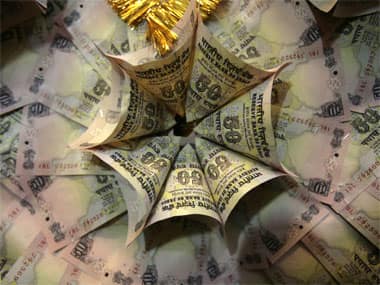Government bond yields are at calendar year highs, while equity indices and the rupee are just off from calendar year highs in the run-up to the Reserve Bank’s annual monetary policy for 2011-12 scheduled for 3 May 2011.
[caption id=“attachment_2724” align=“alignleft” width=“380” caption=“Post the monetary policy, all the markets - bond, equity and currency - are likely to show positive trends, despite the RBI raising interest rates. Reuters”]
 [/caption]
[/caption]
The 10-year benchmark government bond (the 7.80 percent 2021 bond) was trading at 8.07% levels on Wednesday, which is close to the highs of 8.11 percent seen this calendar year.
The Sensex and the Nifty are trading at 19,400 and 5,800 levels respectively, which are a few percentage points off the highs of 20,000 and 6,150 seen in this calendar year. The rupee at Rs 44.50 to the US dollar is off 1 percent from highs of Rs 44.07 seen in 2011 so far.
The market trends going into the policy indicate that bonds are expecting the worst from the policy while equity and currency markets are more or less following their own trends and are quite indifferent to the outcome of the policy.
Post the monetary policy, all the markets - bond, equity and currency - are likely to show positive trends, despite the RBI raising interest rates. The RBI is widely expected to raise the benchmark repo and reverse repo rate by 25-50 basis points (100 basis points make 1 percent) in their policy meet as it is committed to quelling fast rising inflationary expectations.
Inflation as measured by the WPI (Wholesale Price Index) came in at 8.98 percent for the month of March, 2011, almost a percentage point higher than the RBI forecast of 8 percent. Rising oil prices (crude oil is trading at multi-year highs with Brent crude at US$ 123 a barrel and Nymex crude at US$ 112/bbl as of 26 April 2011) are further pressuring rising inflation trends.
Impact Shorts
More ShortsBond yields will fall post policy on the back of expectations that the RBI will temper its monetary policy stance going forward. The RBI has raised the repo rate by 175bps and the reverse repo rate by 225 bps in the last one year. A 25bps or a 50bps hike in the policy rates will take the repo and reverse repo rates to 7-7.25 percent and 6-6.25 percent respectively.
The market will see these policy rates as being close to the end of the RBI tightening regime as the central bank will more likely forecast inflation falling this year from last year’s levels. The market will then take inflation levels of 8.98%, seen in March, 2011, as the peak and will then focus of inflation numbers coming in lower in the coming months.
Equity indices will rally post policy as the market shrugs off the rate hike and focus on the positives of rising foreign institutional investor (FII) flows. FIIs who turned net buyers of US$ 3 billion of equities in March and April after having net sold US$ 2 billion in January and February will continue to pump in money into Indian equities.
The weak US dollar (the US Dollar index (DXY) has lost over 6 percent in the year to date) is increasing the risk appetite amongst global investors and, emerging equities, including India, will benefit from that risk appetite. The US Federal Reserve (Fed) will be the last central bank (leaving out Bank of Japan) to end easy money. Low US interest rates coupled with higher interest rates in countries across the world will prompt carry trades (where speculators borrow in dollar and deploy the proceeds in other markets), leading to a rise in risk asset classes. The record highs seen in gold, silver, the Chinese yuan and the Singapore dollar are all examples of a healthy risk appetite.
The rupee will tend to appreciate against the US dollar post the rate hike as interest rate differentials between the US and India widen. The US Federal Reserve Board (Fed’s) policy rate (the Fed Funds rate) is between 0-0.25 percent while the RBI’s policy rate will be at 7-7.25 percent (the repo rate). The high rate differential will spur flows into rupee assets, leading to rupee appreciation.
Arjun Parthasarathy has spent 20 years in the financial markets, having worked with Indian and multinational organisations. His last job was as head of fixed income at a mutual fund. An MBA from the University of Hull, he has managed portfolios independently and is currently the editor of www.investorsareidiots.com </a>. The website is for investors who want to invest in the right financial products at the right time.
)